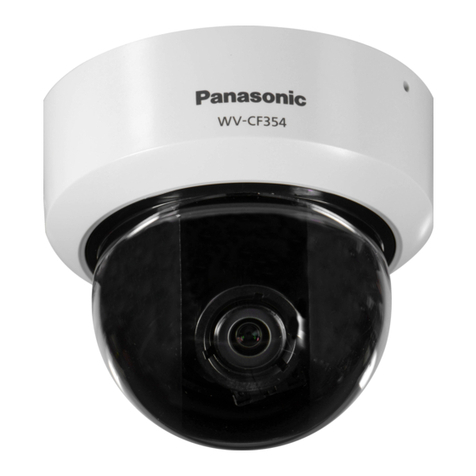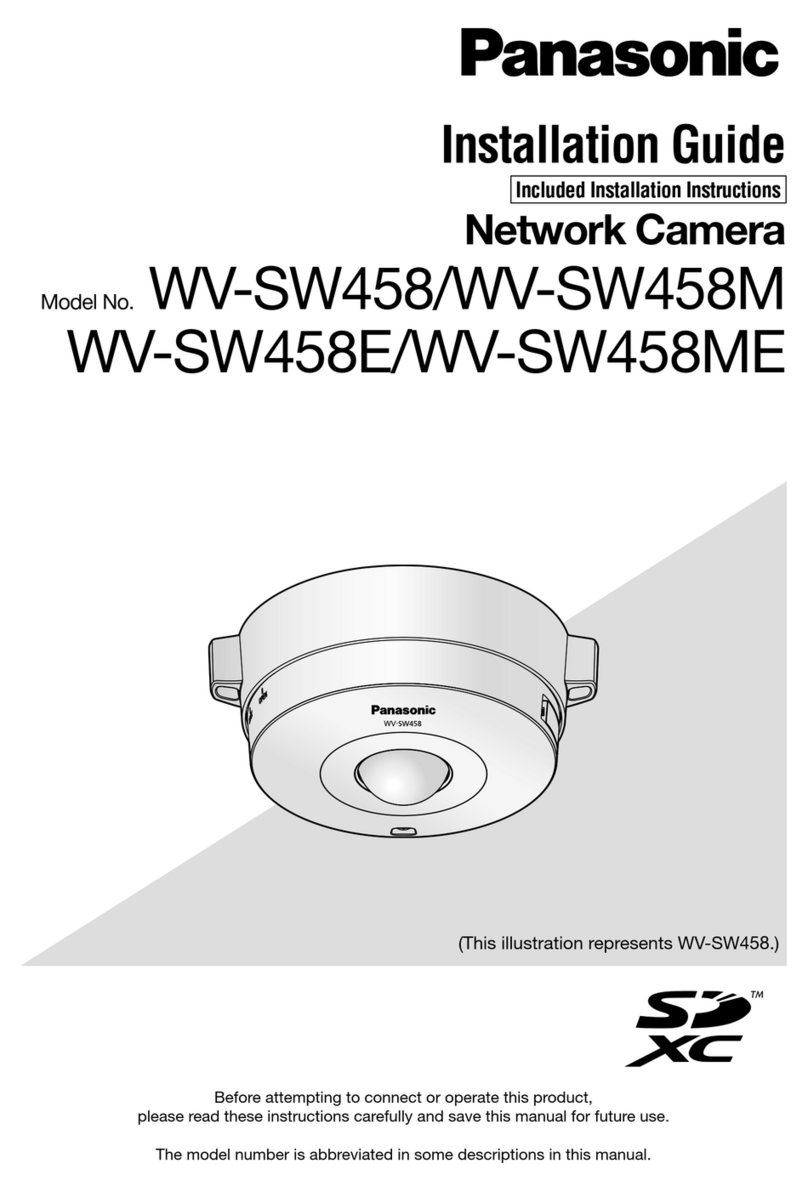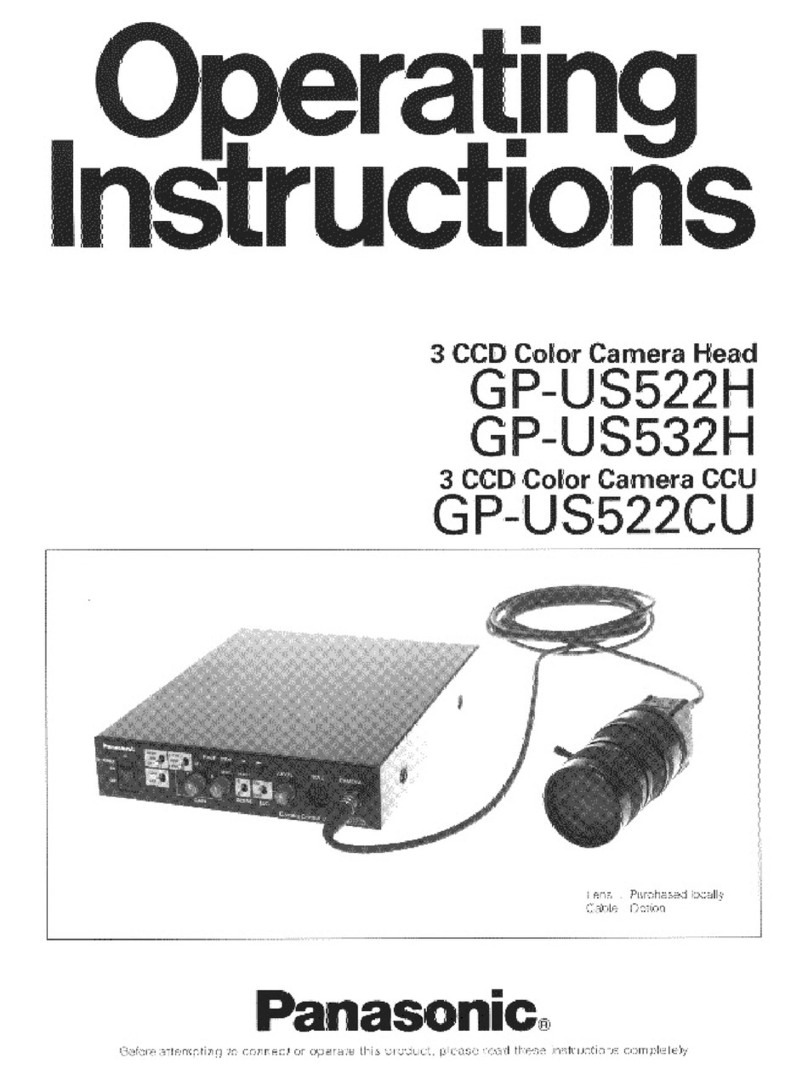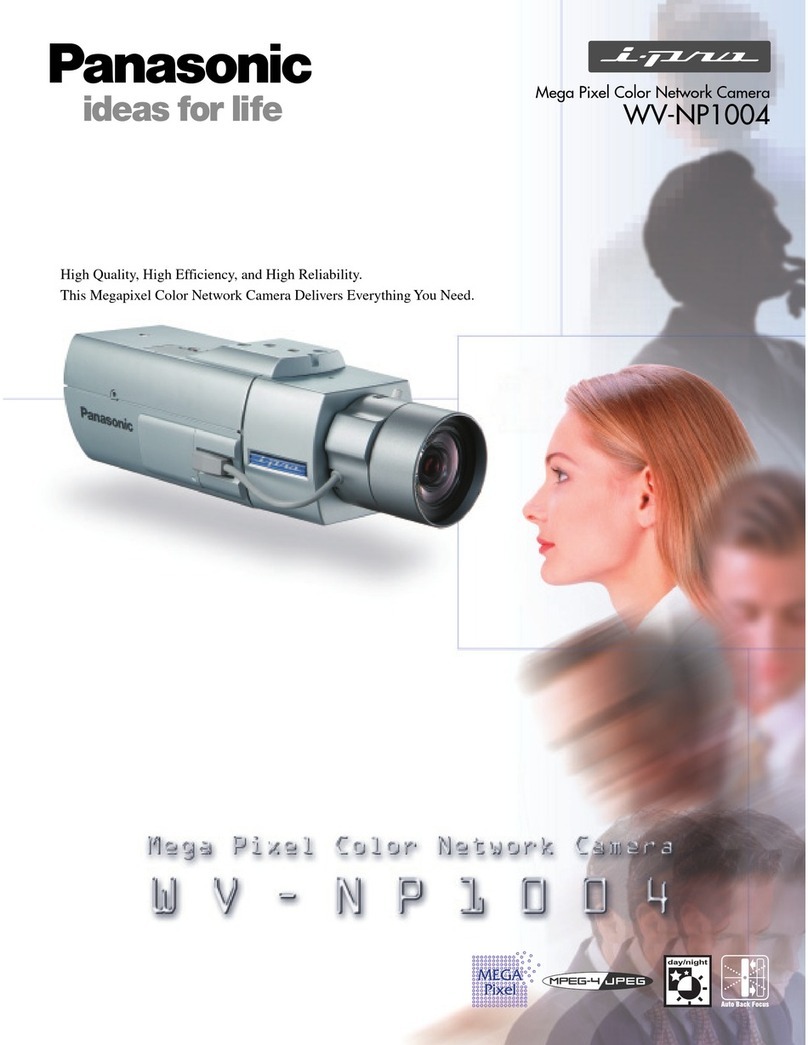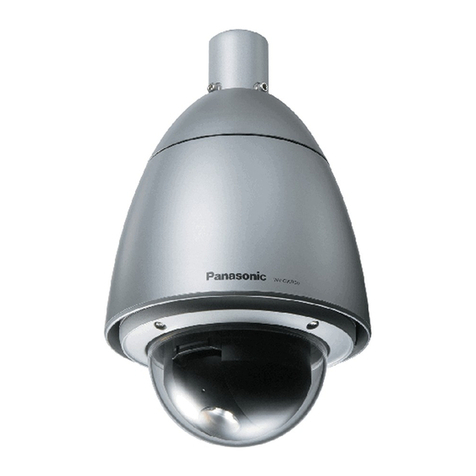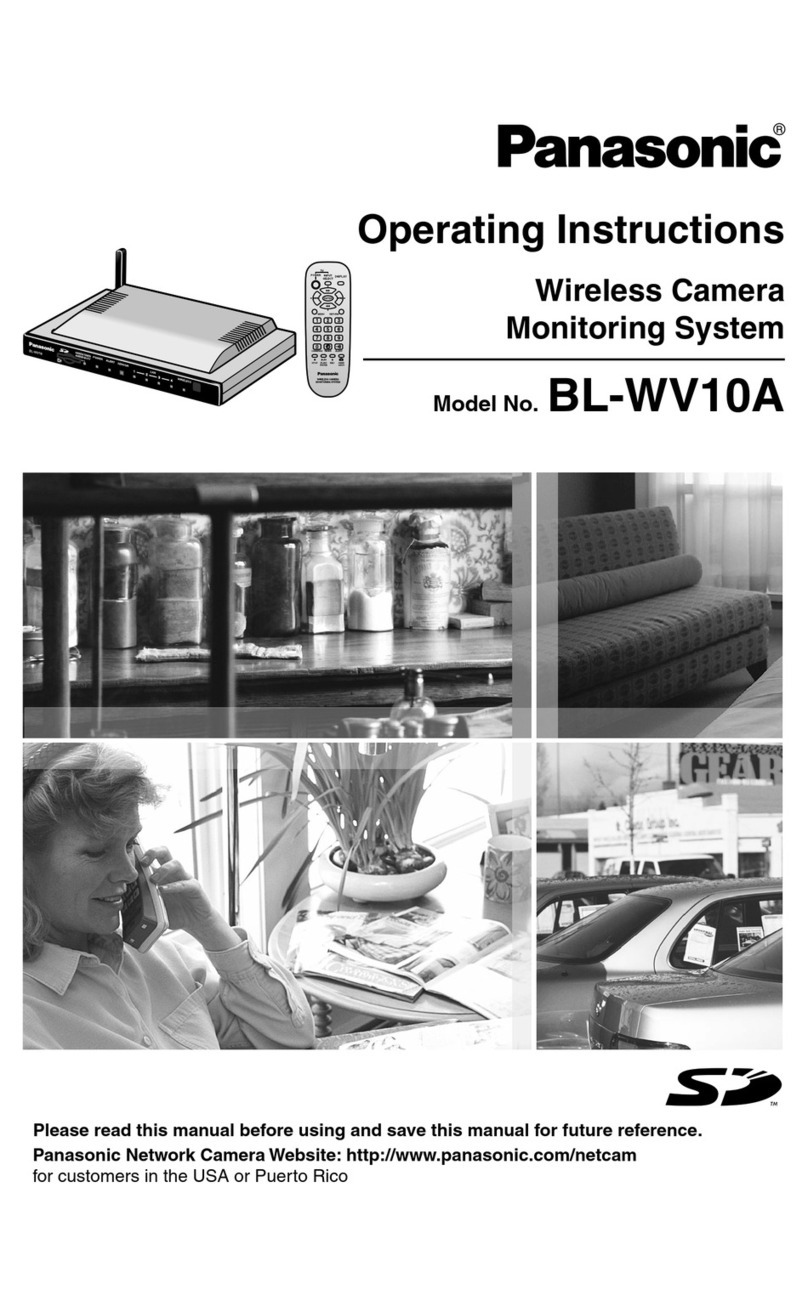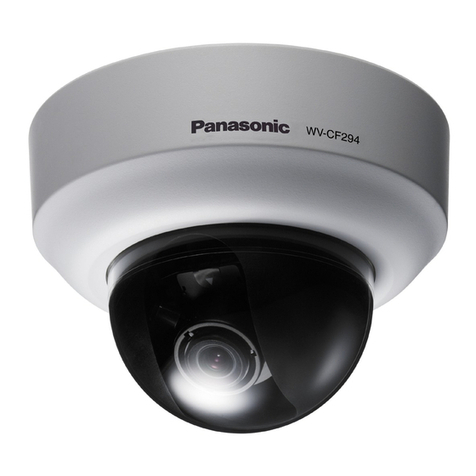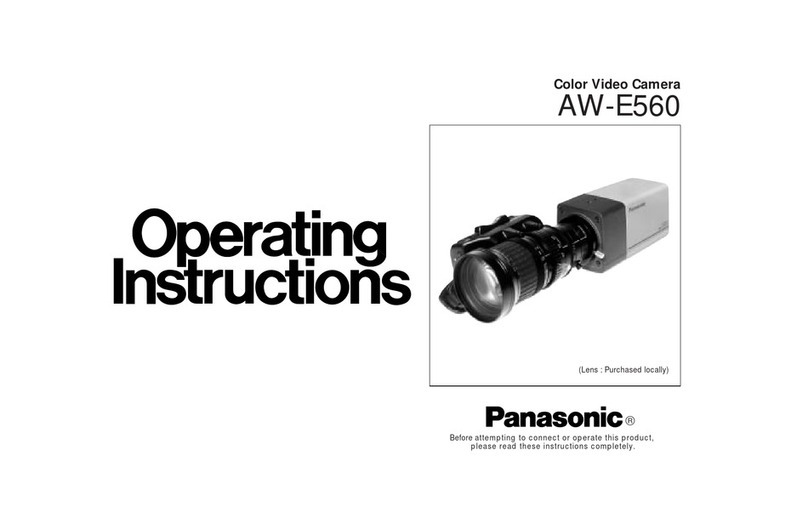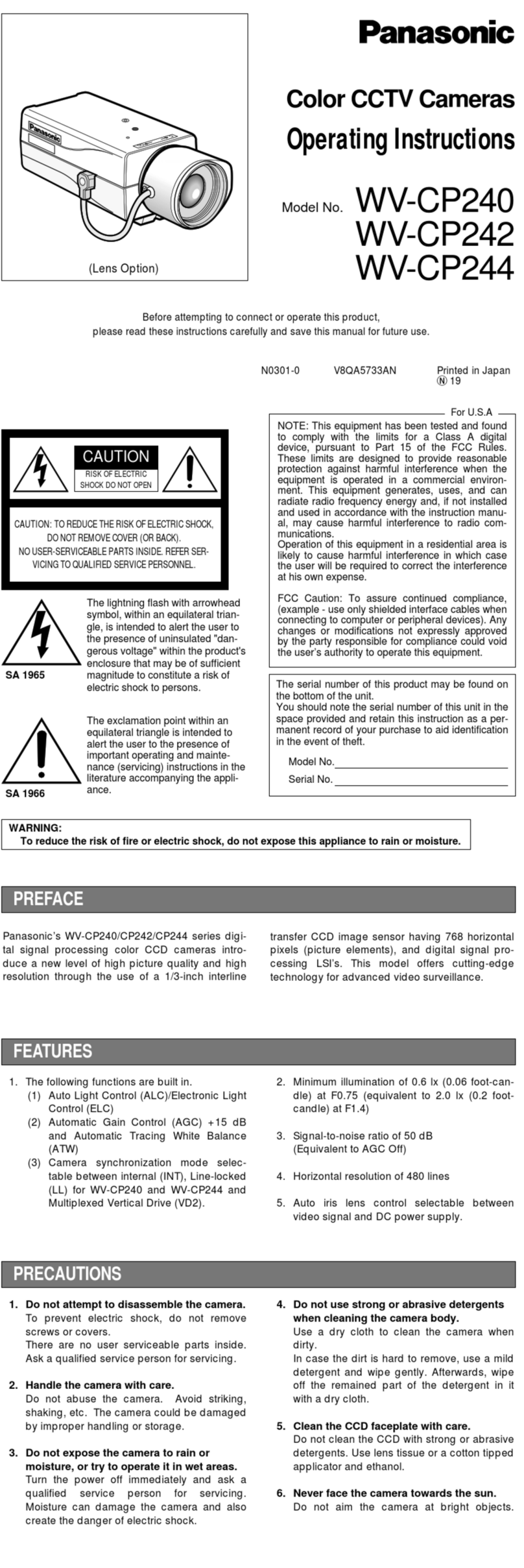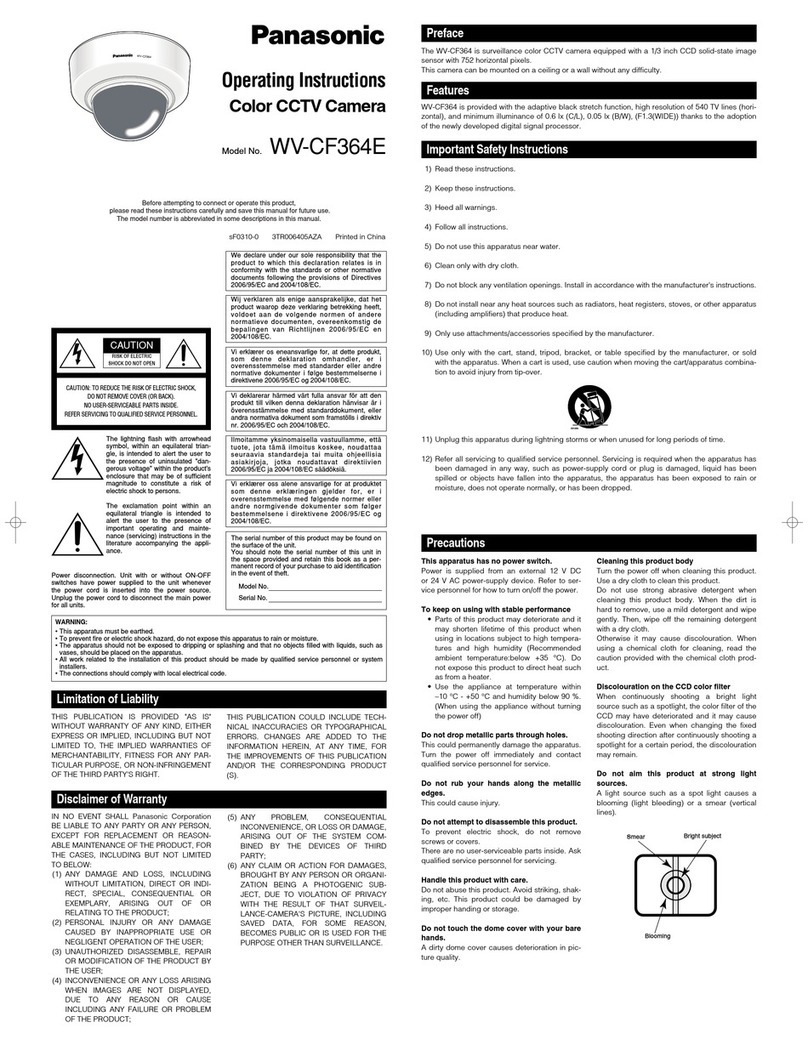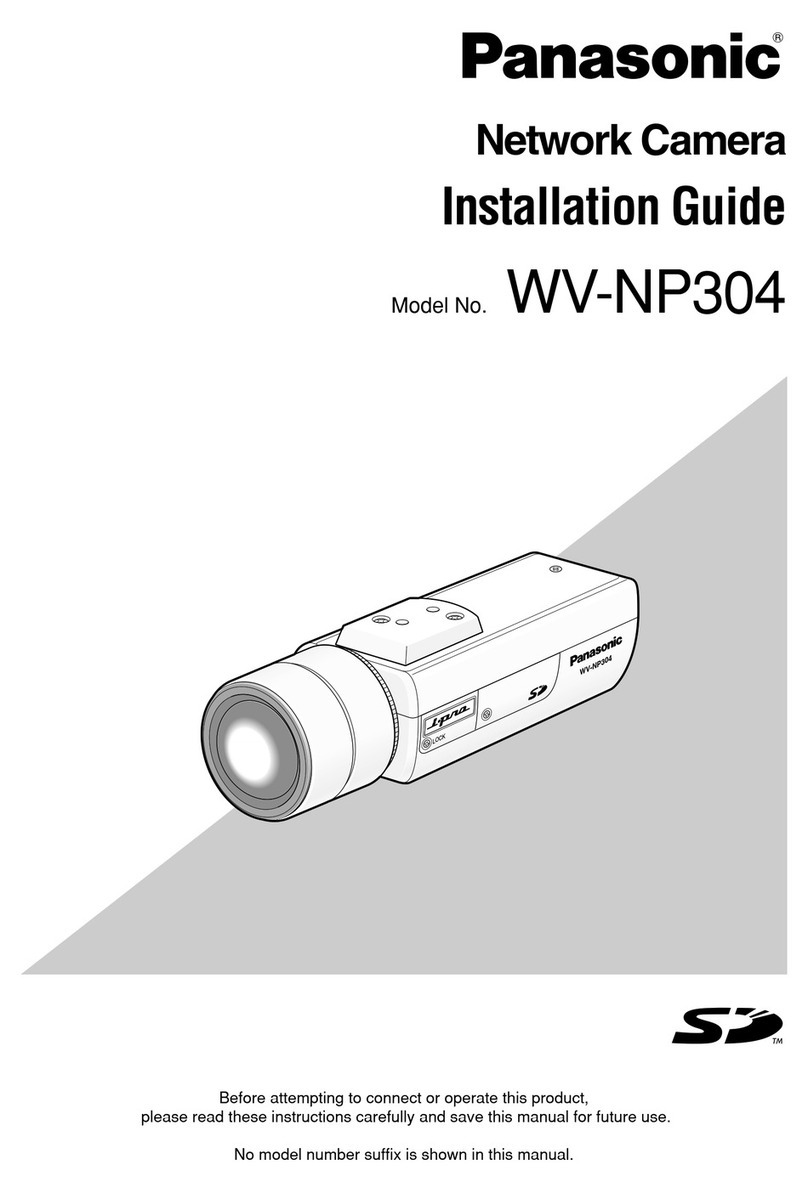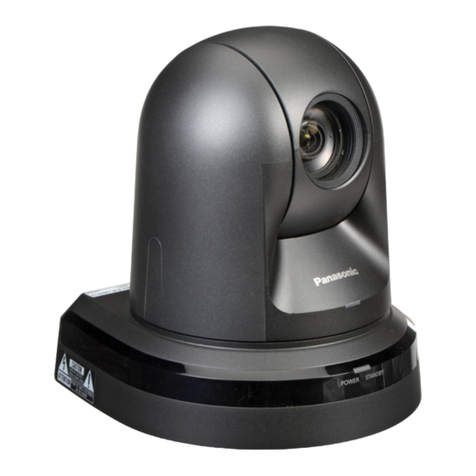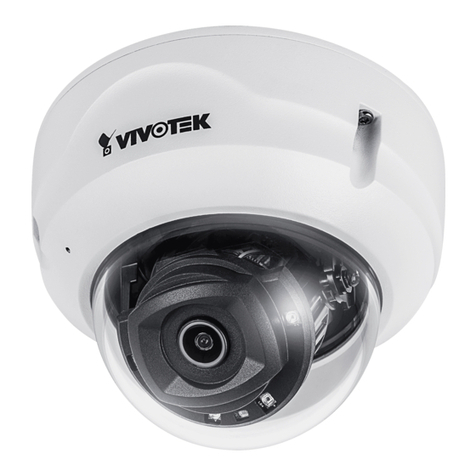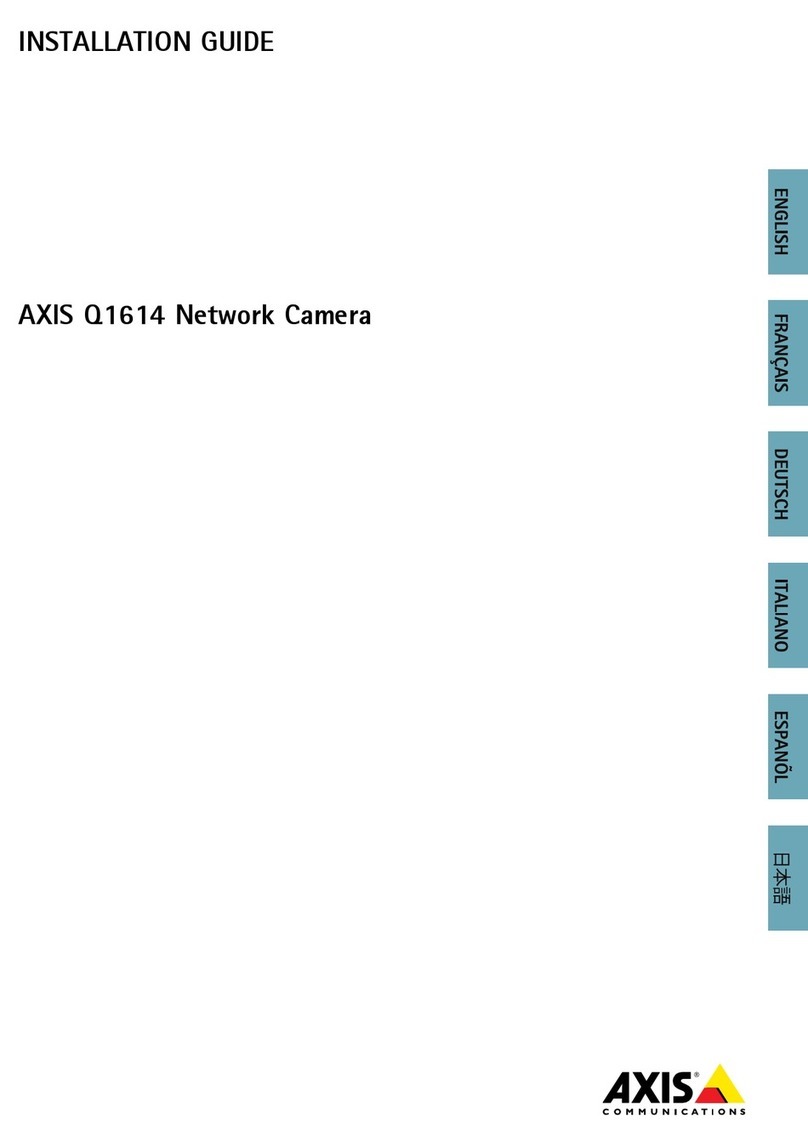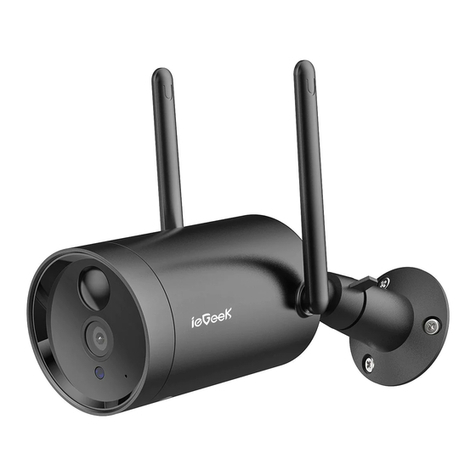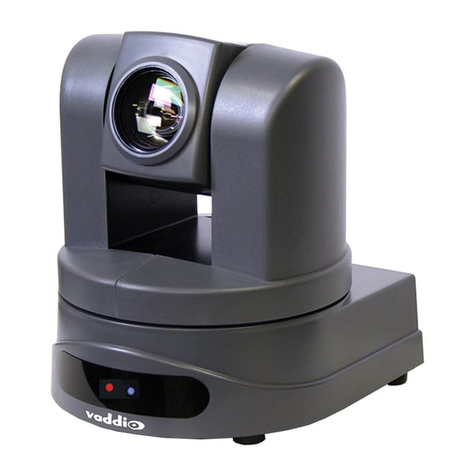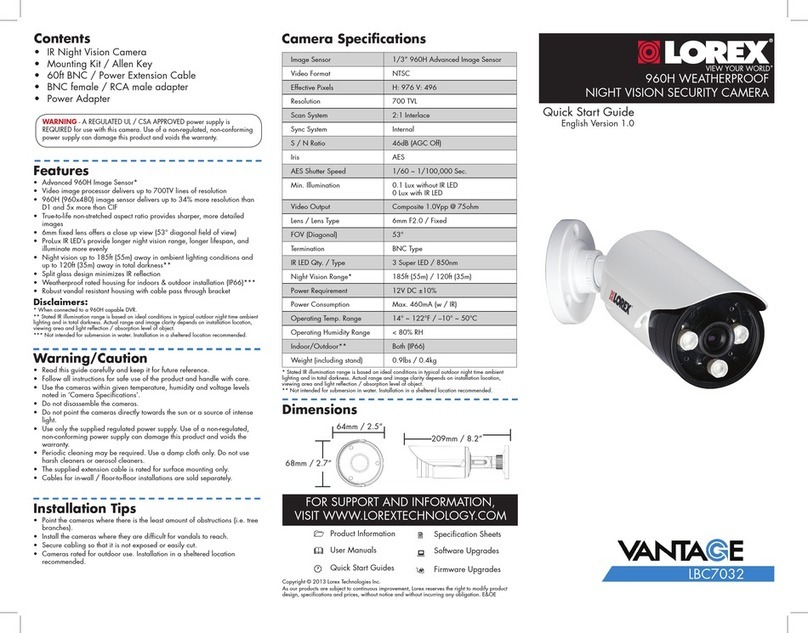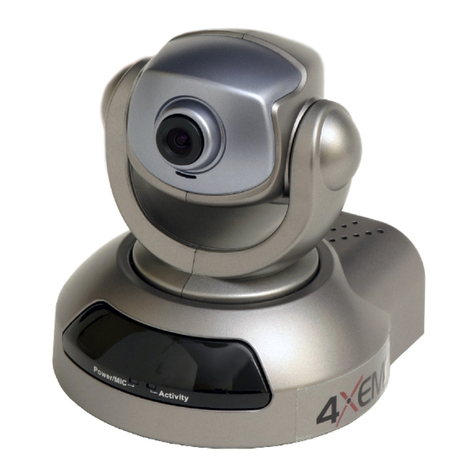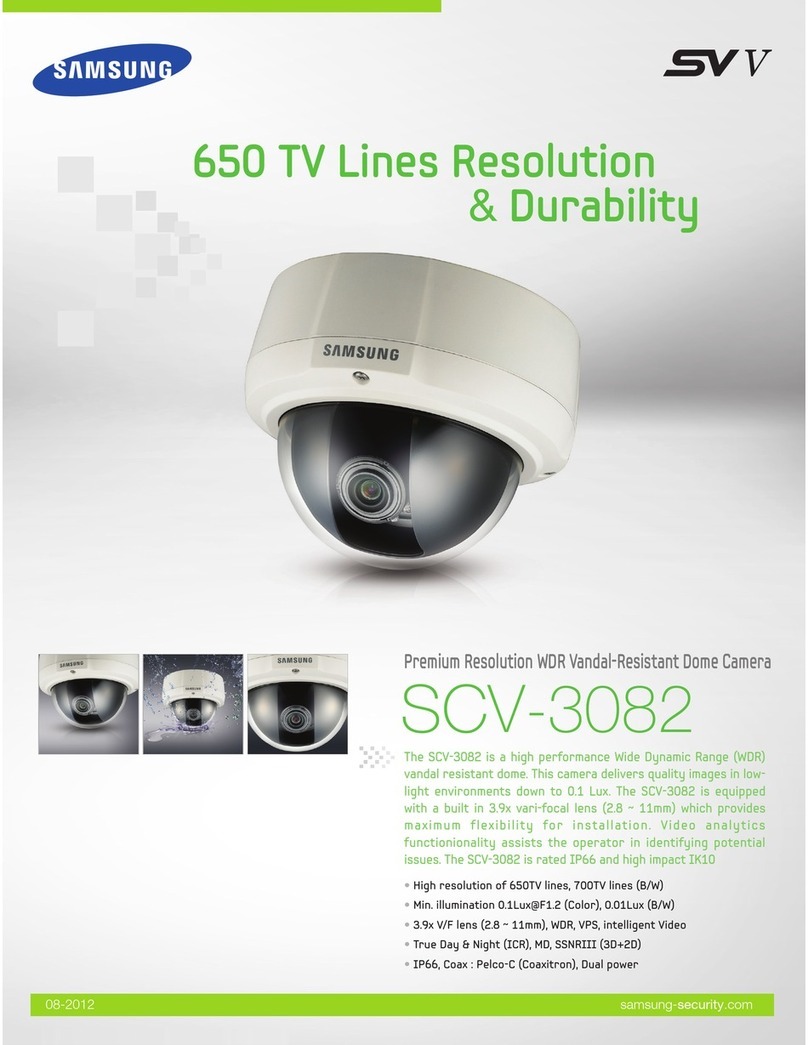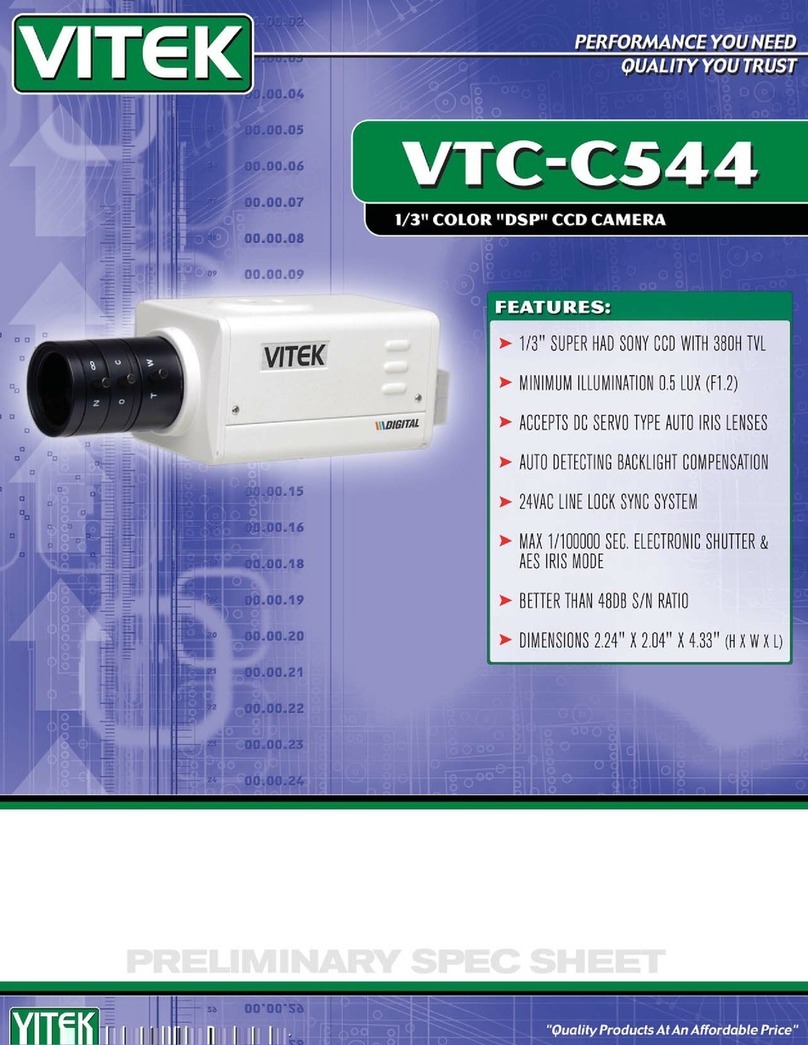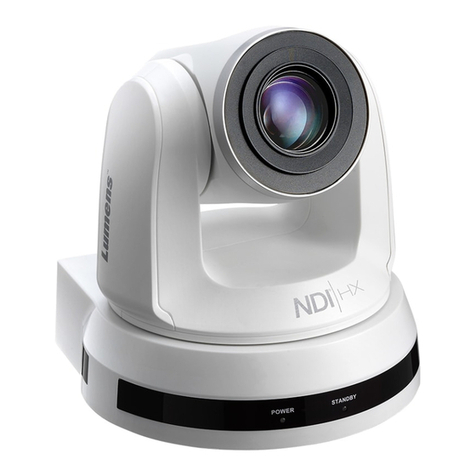
Auto focus (AF) button
SF N 311
SF R 311
Focus Assist (F.A.) button
SF N 310
SF R310
Network Camera
Model No. WV-SFR311/WV-SFR310
WV-SFN311/WV-SFN310
(This illustration represents WV-SFN311.)
● This manual describes the installation procedures, network camera installation, cable connections,
and the angle of view adjustment.
● Before reading this manual, be sure to read the Important Information.
● This manual describes how to install the network camera using model WV-SFN311 as an example.
PGQX1560XA sL0514-2064 Printed in China
Standard accessories
Important Information ............................... 1 pc.
Installation Guide (this document) ............ 1 set
Warranty card ........................................... 1 set
CD-ROM*1 ................................................ 1 pc.
Code label*2 .............................................. 1 pc.
*1 The CD-ROM contains the operating instructions and different kinds of tool software programs.
*2 This label may be required for network management. The network administrator shall retain the
code label.
The following parts are used during installation procedures.
Ⓐ Attachment plate .................................. 1 pc.
Ⓑ Bit ......................................................... 1 pc.
Ⓒ
Template A (for the attachment plate)
1 sheet.
Ⓓ Power cord plug ................................... 1 pc.
Ⓔ External I/O terminal plug .................... 1 pc.
Ⓕ MONITOR OUT conversion plug ......... 1 pc.
Ⓖ Cable tie ............................................. 2 pcs.
(of them, 1 for spare)
Ⓑ Ⓓ Ⓔ
4321
Enclosure
Camera xing screw
Dome cover
Tilting table
Azimuth
adjustment ring
Panning table
Camera Ⓐ Attachment plate
(accessory)
Major operating controls
The component names of the camera are as follows. Refer to the illustration when installing or
adjusting the camera.
● The MONITOR OUT terminal output can be switched for the NTSC monitor/PAL monitor.
● How to initialize the camera
Follow the steps below to initialize the network camera.
q Turn off the power of the camera. When using a PoE hub, disconnect the LAN cable from
the camera. When using an external power supply, disconnect the power cable plug from
the 12 V DC power supply terminal.
w Turn on the power of the camera while holding down the INITIAL SET button, and then
keep holding down the button for 5 seconds or more. About 2 minutes later, The camera will
start up and the settings including the network settings will be initialized.
● When data is being sent via the network camera Blinks green (accessing)
●
When the camera is able to communicate with the connected device
Lights orange
● When an SD memory card*1 is inserted and could Lights off → Blinks green →
be recognized Lights off
● When data can be saved after the SD memory card is Lights off → Lights green
inserted and the SD ON/OFF button is pressed
● When data can be saved to the SD memory card Lights green
● When the SD memory card is removed after holding down
Lights green → Blinks green → Lights off
the SD ON/OFF button for about 2 seconds
●
When data cannot be saved to the SD memory card because
Lights off
an abnormality was detected or the SD memory card is
configured not to be used
●
When AF (Auto Focus) operation is being executed
SF N 311 SF R 311
Blinks red (Interval of 1 time/ second)
●
When the focus assist function is activated
SF N 310 SF R310 Blinks red (1 time)
● When the focus ring is positioned near the best Lights red
focus position SF N 310 SF R310
● When the set is being started Lights red
● When an SD memory card is recognized normally Lights red → Lights off
● When an abnormality is detected in SD card or the Lights red
SD slot is not used after the camera has started.
IMPORTANT:
● This is valid if the [Monitor out] is set to [Switch priority] ([Switch priority] is selected by
default).
For details, refer to the Operating Instructions (included in the CD-ROM).
IMPORTANT:
● When the camera is initialized, the settings including the network settings will be initial-
ized. Note that the CRT key (SSL encryption key) used for the HTTPS protocol will not
be initialized.
● Before initializing the settings, it is recommended to write down the settings in advance.
● Do not turn off the power of the camera during the process of initialization. Otherwise, it
may fail to initialize and may cause malfunction.
*1 SDXC/SDHC/SD memory card is described as SD memory card.
*2 Depending on the scanning application used, the Data Matrix may not be able to be
read correctly. In this case, access the site by directly entering the following URL.
http://security.panasonic.com/pss/security/support/qr_sp_select.html
● FRONT must positioned
in front of the camera
(on the Panasonic logo
side).
Making connections
Turn off each system’s power supply before making a connection. Before making connections,
prepare the required peripheral devices and cables.
Before starting the installation, check the entire system configuration. The following illustration
gives a wiring example of how to connect the camera to the network via a PoE device (hub).
<Required cable>
LAN cable (category 5 or better, straight, STP: For Europe)
Use a LAN cable (category 5 or better, cross) when directly connecting the camera to a PC.
*1 Recommended cable length from the speaker : less than 10 m {32.8 feet}
Recommended cable length from the microphone : less than 1 m {3.28 feet}
When connecting to a network using a PoE hub
Note:
● Since the connector storage section
does not have a sufficient space, use
audio cables and a LAN cable that do
not exceed the sizes described in the
illustrations.
IMPORTANT:
● Connect/disconnect the audio cables and turn on the power of the camera after turning
off the power of the audio output devices. Otherwise, loud noise may be heard from
the speaker.
● Make sure that the stereo mini plug is connected to this cable. When a monaural mini
plug is connected, audio may not be heard.
When connecting a monaural speaker with amplifier, use a locally procured conversion
cable (mono-stereo).
Connect an external amplifier-embedded speaker to the audio output cable
SF N 311
SF R 311
Connect a stereo mini plug (ø3.5 mm) (Audio output is monaural.). Use an external powered speaker.
● Output impedance : Approx. 600 Ω (unbalanced)
● Recommended cable length : Less than 10 m {32.8 feet}
● Output level : –20 dBV
Microphone/line input cable
SF N 311
SF R 311
Connect a monaural mini plug (ø3.5 mm).
● Input impedance: Approx. 2 kΩ (unbalanced)
● Recommended cable length: Less than 1 m {3.28 feet} (for microphone input)
Less than 10 m {32.8 feet} (for line input)
● Recommended microphone: Plug-in power type (option) ●Supply voltage: 2.5 V ±0.5 V
● Recommended sensitivity of microphone: –48 dB ±3 dB (0 dB=1 V/Pa,1 kHz)
● Input level for the line input: Approx. –10 dBV
IMPORTANT:
● Use all 4 pairs (8 pins) of the LAN cable.
● The maximum cable length is 100 m {328 feet}.
● Make sure that the PoE device in use is compliant with IEEE802.3af standard.
● When connecting both the 12 V DC power supply and the PoE device for power
supply, 12 V DC will be used for power supply.*
* If a 12 V DC power supply and a PoE hub or router are used at the same time,
network connections may not be possible. In this case, disable the PoE settings.
Refer to the operating instructions of the PoE hub or router in use.
* In the situation where a 12 V DC power supply and a PoE hub or router are used at the
same time and the 12 V DC power supply is then disconnected, the power supply may
be stopped and the camera may restart depending on the PoE hub or router used.
● When the LAN cable is disconnected once, reconnect the cable after around
2 seconds. When the cable is quickly reconnected, the power may not be supplied
from the PoE device.
IMPORTANT:
● Do not connect 2 wires or more directly to a terminal. When it is necessary to con-
nect 2 or more wires, use a splitter.
● Off, input, and output of the external I/O terminal 2 and 3 can be switched by con-
figuring the setting. Refer to the Operating Instructions on the provided CD-ROM
for further information about the EXT I/O terminal 2 and 3 (ALARM IN2, 3) settings
(“Off”, “Alarm input”, “Alarm output” or “AUX output”).
● Install external devices so that they do not exceed the rating of the network camera.
● When using the EXT I/O terminals as the output terminals, ensure they do not
cause signal collision with external signals.
IMPORTANT:
● The adjustment monitor is used for checking the adjustment of the angular field of
view when installing the camera or when servicing. It is not provided for recording/
monitoring use.
● Depending on the monitor, some characters (camera title, preset ID, etc.) may not
be displayed on the screen.
● Use a switching hub or a router which is compliant with 10BASE-T/100BASE-TX.
● If a PoE hub is not used, each network camera must be connected to a 12 V DC
power supply.
● When using 12 V DC, power supply from a PoE hub or router is not required.
Connect a LAN cable (category 5 or better, straight, STP: For Europe)
Connect the alarm input/output cable
Connect a LAN cable (category 5 or better, straight, STP: For Europe) to the network connector.
Connect the cables of external devices to the EXT I/O terminal plug (accessory).
q When connecting an external device, remove 8 mm - 9 mm {5/16 inches - 11/32 inches} of
the outer jacket of the cable and twist the cable core to prevent the short circuit first.
Specification of cable (wire): 20 AWG - 26 AWG, Single core, twisted
w Push down the button of the desired terminal on the external I/O terminal plug with a ball-
point pen, and release the button when the cable of the external device is fully inserted
into the terminal hole.
Note:
● Check whether the stripped part of the wire is not exposed and is securely connected.
<Ratings>
● ALARM IN1(DAY/NIGHT IN), ALARM IN2, ALARM IN3
Input specication : No-voltage make contact input (4 V - 5 V DC, internally pulled up)
OFF : Open or 4 V - 5 V DC
ON : Make contact with GND (required drive current: 1 mA or more)
● ALARM OUT, AUX OUT
Output specication
: Open collector output (maximum applied voltage: 20 V DC)
Open : 4 V - 5 V DC by internal pull-up
Close : Output voltage 1 V DC or less (maximum drive current: 50 mA)
* The default of EXT I/O terminals is “Off”.
IMPORTANT:
● The 12 V DC power supply shall be insulated from the commercial AC power.
● Be sure to use the power cable plug provided with this product.
● Be sure to fully insert the power cable plug into the 12 V DC power supply terminal.
Otherwise, it may damage the camera or cause malfunction.
● When installing the camera, make sure that excessive force is not applied to the
power cable.
● Be sure to use an AC adaptor compliant with the Specifications (written in the indi-
cation label on the bottom side of this unit) regarding power source and power con-
sumption.
Caution:
● A READILY ACCESSIBLE DISCONNECT DEVICE SHALL BE INCORPORATED
TO THE EQUIPMENT POWERED BY 12 V DC POWER SUPPLY.
● ONLY CONNECT 12 V DC CLASS 2 POWER SUPPLY (UL 1310/CSA 223) or
LIMITED POWER SOURCE (IEC/EN/UL/CSA 60950-1).
Connect the power cable
Connect the output cable to the power cable plug (accessory).
q Loosen the screw of the power cable plug (accessory), strip 3 mm to 7 mm {1/8 inches to
9/32 inches} from the end of the wire, twist the stripped part of the wire sufficiently to avoid
short circuit, and then connect the output cable to the power cable plug (accessory).
w Tighten the screw of the power cable plug. (Recommended tightening torque: 0.34 N·m
{0.25 lbf·ft})
Note:
● Check whether the stripped part of the wire is not exposed and is securely con-
nected.
● When connecting an external power supply to the camera, use the 16 AWG to 24
AWG single-wired or stranded wired cables.
(Screw size 6.35 mm
{1/4 inches} torx wrench)
MONITOR OUT terminal
(factory shipment:
NTSC monitor)
12 V DC power
supply terminal
Direction marker for installation
( TOP) Data Matrix: To
our website*2
For U.S. and Canada:
Panasonic System Communications
Company of North America,
Unit of Panasonic Corporation
of North America
www.panasonic.com/business/
For customer support, call 1.800.528.6747
Two Riverfront Plaza, Newark, NJ 07102-5490
Panasonic Canada Inc.
5770 Ambler Drive, Mississauga,
Ontario, L4W 2T3 Canada
(905)624-5010
www.panasonic.ca
For Europe and other countries:
Panasonic Corporation
http://panasonic.net
Panasonic System Networks Co., Ltd.
Fukuoka, Japan
Authorised Representative in EU:
Panasonic Testing Centre
Panasonic Marketing Europe GmbH
Winsbergring 15, 22525 Hamburg, Germany
Installation Guide
Included Installation Instructions
Screen display
top (TOP)
● As necessary, use a cable tie
(accessory) to tie the cables
together.
Panasonic System Networks Co., Ltd. 2014
* The external I/O terminal plug and power cord plug are attached to the camera.
30 mm
{1-3/16 inches}
Straight section
30 mm {1-3/16 inches}
40 mm {1-9/16 inches}
9 mm
{11/32 inches}
13 mm {1/2 inches}
Straight section
17 mm {21/32 inches}
ø9 mm
{11/32 inches}
Example of
audio cable connector
Example of LAN cable
connector
4321
button GND
ALARM IN3, AUX OUT
(Alarm input terminal 3, AUX output terminal)
ALARM IN2, ALARM OUT
(Alarm input terminal 2, Alarm output terminal)
ALARM IN1, DAY/NIGHT IN
(Alarm input terminal 1, DAY/NIGHT input terminal)
Ⓔ External I/O terminal plug (accessory)
SD ON/OFF button
SD slot
Direction marker
for installation
(FRONT )
LINK indicator
INITIAL SET button
NTSC/PAL switch
SD MOUNT indicator
ACT indicator
Powered speaker Adjustment monitor PoE device (hub)
LAN cable
(category 5 or better, straight,
STP: For Europe)
PC
LAN cable (category 5
or better, straight,
STP: For Europe)
LAN cable
(category 5 or better, straight,
STP: For Europe)
Adjustment monitor
Recommended total extended
cable length*1
Microphone
Powered speaker
Microphone
SD ERROR/AF indicator SF N 311
SF R 311 F.A. indicator SF N 310
SF R310
Built-in microphone
SF N 310
● Points up when installing
to a wall.
Inner dome



